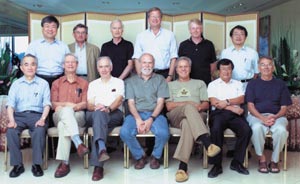
The International Committee for Future Accelerators (ICFA) has accepted that superconducting technology should be used for a future electron-positron linear collider in the energy range 0.5 to 1.0 TeV – now to be known as the International Linear Collider. In making this decision, ICFA unanimously followed the advice of the International Technology Recommendation Panel (ITRP), which had been charged last November with evaluating and then choosing between two possible technologies, generally referred to simply as “warm” and “cold”.
The two technologies, which have been developed in America, Asia and Europe over the past decade, differ mainly in their accelerating structures. In the “warm” version the accelerating cavities are normally conducting and operate at room temperature, while the “cold” technology is based on superconducting cavities that work at a temperature of 2 K.
The normally conducting technology, which has been developed jointly by the Next Linear Collider and Global Linear Collider collaborations, operates at a frequency of 11.4 GHz, in the “X-band” range, with copper accelerating cavities. It would require a tunnel up to 30 km long, with a second parallel tunnel to house the klystrons needed to generate the radiofrequency accelerating fields.
At 1.3 GHz the operating frequency of the accelerating cavities for the superconducting technology, developed by the TESLA collaboration, lies in the “L-band” region. Such a machine would require a longer tunnel, up to 40 km long. However, with superconducting niobium, the transfer of power from the drive klystrons to the electron and positron beams is highly efficient, and nearly all the power is transmitted to the beam; in the warm technology only around one-third of the power is transmitted.
In November last year ICFA’s International Linear Collider Steering Committee (ILCSC) appointed the ITRP, comprising 12 experts from America, Asia and Europe under the chairmanship of Barry Barish from the California Institute of Technology. The panel met six times as it progressed from initial planning through visits to test facilities at DESY, KEK and SLAC, to its final deliberations and a conclusion. The members of the panel essentially gave up their normal work for six months while they interacted intensively with the international particle-physics community and with each other. They finally presented their recommendation to ICFA and the ILCSC at a special meeting in Beijing on 19 August. ICFA’s endorsement was announced on the following day at the ICHEP’04 meeting in Beijing.
“Both the ‘warm’ X-band technology and the ‘cold’ superconducting technology would work for a linear collider,” explains Barish. “Each offers its own advantages and each represents many years of R&D by teams of extremely talented and dedicated scientists and engineers. At this stage it would be too costly and time consuming to develop both technologies toward construction. The decision was not an easy one, because both technologies were well advanced and we knew the selection would have significant consequences for the participating laboratories.”
To help arrive at a recommendation, the panel developed a matrix of evaluation criteria. These included issues of cost and schedule as well as technical and physics operation issues. In the end the superconducting technology had features that tipped the balance in its favour, some of which stem from its lower frequency. The ITRP did however recognize the importance of the work that has been done on warm technology.
In addition to the much lower power consumption of superconducting technology, the panel cited the large cavity aperture and long bunch interval, which simplify operations, reduce the sensitivity to ground motion, permit inter-bunch feedback and may enable increased beam current. They also concluded that the main linac and radiofrequency systems are of lower risk. The construction of the superconducting X-ray free-electron laser will provide prototypes and test many aspects of the linac, and the industrialization of most of the major components for such a linac is already underway.
The panel was keen to stress that it had interpreted its mandate as being to choose a technology not a design. The decision by ICFA to accept the panel’s recommendation will now allow the next big step to be taken, to develop the technical design for the International Linear Collider as rapidly as possible. The ILCSC has already secured an agreement that America, Asia and Europe will work together under a central team, and a director and site for the team are now being sought.








